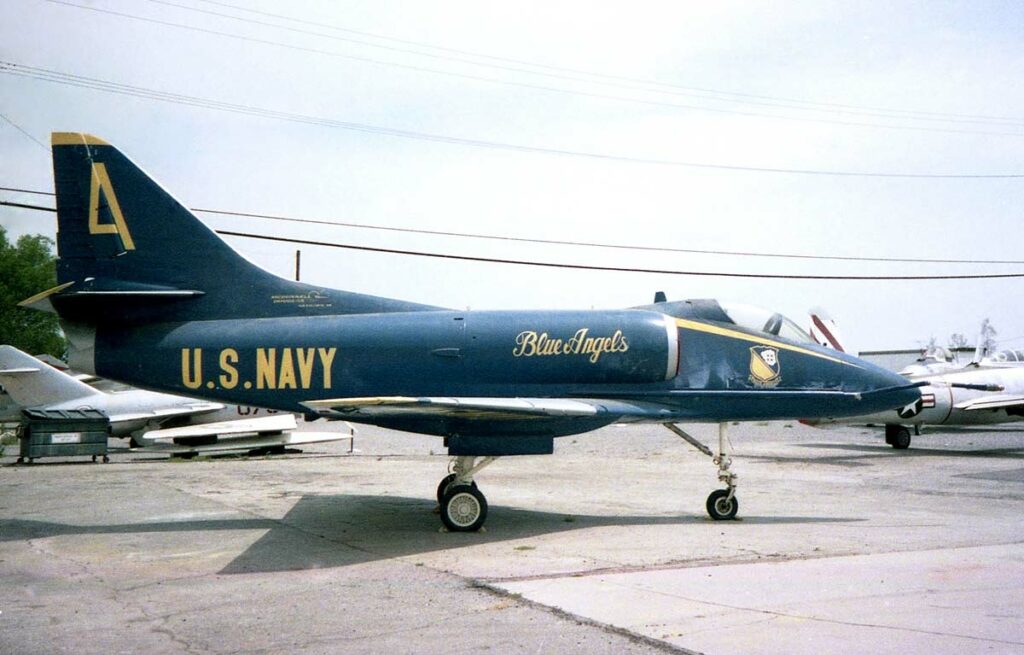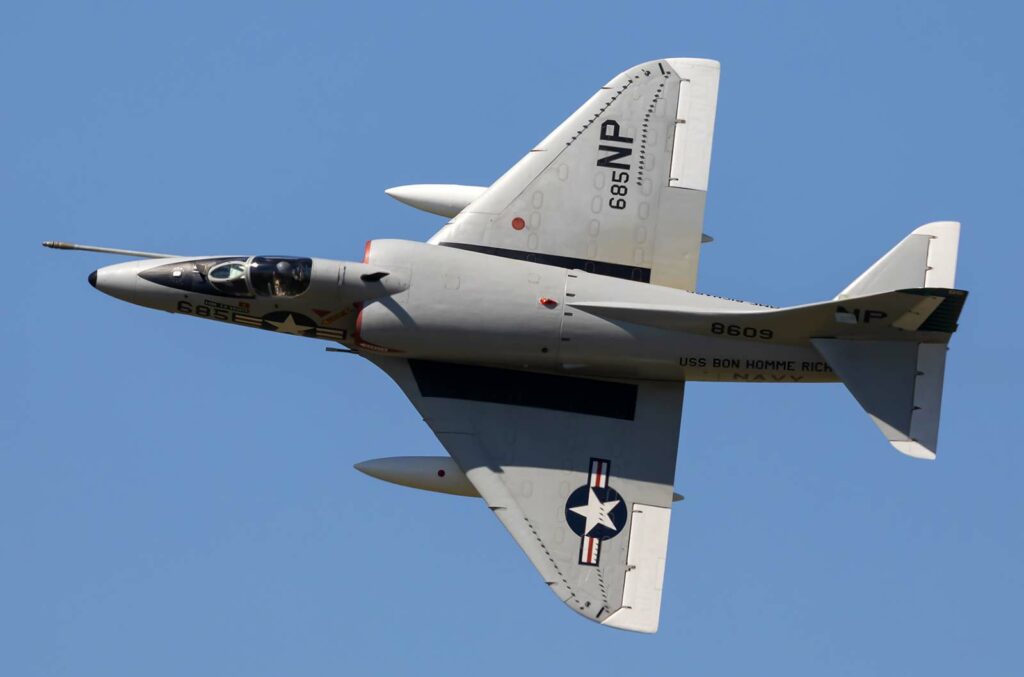The Douglas A-4 Skyhawk is a single-engine, carrier-capable light attack aircraft, known for its agility and effectiveness in ground and maritime attack roles.
In Brief
The Douglas A-4 Skyhawk is a single-engine light attack aircraft designed for the U.S. Navy and Marine Corps. With a maximum takeoff weight of 11,100 kg (24,500 lbs), it is recognized for its compact design and impressive performance. Powered initially by the Wright J65 turbojet and later by the Pratt & Whitney J52, the Skyhawk achieves speeds over 600 miles per hour. Notable for its five hardpoints supporting various munitions, including the ability to carry nuclear weapons, it has a distinguished combat history. The Skyhawk’s design features a delta wing, tricycle undercarriage, and a cruciform tail, with armaments including two 20mm Colt Mk 12 cannons and a variety of missiles and bombs.
The Douglas A-4 Skyhawk, a lightweight yet powerful attack aircraft, played a significant role in various conflicts since its introduction in the 1950s. Renowned for its agility and effectiveness in both ground and maritime attack roles, the Skyhawk served in multiple national air forces and has a storied operational history.

History of the Development of the Douglas A-4 Skyhawk:
In the early 1950s, the United States Navy sought a jet-powered attack aircraft to replace the piston-powered Douglas AD Skyraider. The response was the development of the Douglas A-4 Skyhawk, designed by Douglas Aircraft’s Ed Heinemann. Heinemann’s design focused on minimizing size, weight, and complexity, resulting in an aircraft that weighed only half of the Navy’s weight specification. Its compact wing did not require folding for carrier storage, a significant innovation at the time.
The Skyhawk, affectionately nicknamed “Scooter,” “Kiddiecar,” “Bantam Bomber,” and “Heinemann’s Hot-Rod,” set a world speed record of 695.163 mph on October 15, 1955. Its conventional post-World War II design featured a delta wing, tricycle undercarriage, and a single turbojet engine in the rear fuselage, with air intakes on the fuselage sides. The tail was of cruciform design, with the horizontal stabilizer mounted above the fuselage. The Skyhawk’s armament consisted of two 20 mm Colt Mark 12 cannons, one in each wing root, and a variety of bombs, rockets, and missiles.
The Navy issued a contract for the type on June 12, 1952, and the first prototype flew from Edwards Air Force Base, California, on June 22, 1954. Deliveries to Navy and Marine Corps squadrons commenced in late 1956. The Skyhawk remained in production until 1979, with 2,960 aircraft built, including 555 two-seat trainers.
Design of the Douglas A-4 Skyhawk:
The Douglas A-4 Skyhawk was designed with a focus on reducing complexity, weight, and size. The aircraft’s compact and unfolded wing, designed for carrier stowage, was a hallmark of its design. The short-span delta wing eliminated the need for wingtip folding, saving weight and space. The leading-edge slats were designed to drop automatically by gravity and air pressure, further reducing the aircraft’s weight.
The Skyhawk was initially powered by the Wright J65 turbojet engine, with later models using the Pratt & Whitney J52 engine. The aircraft had a maximum takeoff weight of 11,100 kg (24,500 lbs) and was capable of speeds over 600 miles per hour. The design included five hardpoints for carrying a variety of bombs, missiles, and other weapons. It was also capable of delivering nuclear weapons using a loft technique and a low-altitude bombing system.
The Skyhawk’s innovative design also featured an all-new enlarged canopy for improved pilot visibility in the A-4M Skyhawk II model, as well as an increased maximum takeoff weight (MTOW) capacity, allowing for an additional array of weaponry to be fitted. The A-4M model was fitted with an even more powerful J52-P-408 powerplant, increasing range and overall speed.
Performance of the Douglas A-4 Skyhawk:
The Douglas A-4 Skyhawk’s performance was characterized by its speed and agility. The aircraft could reach a maximum speed of 645 mph (1,038 kph | 560 knots), with a service ceiling of 38,698 ft (11,795 m | 7 miles) and a range of 2,001 miles (3,220 km | 1,739 nm). Its rate of climb was 10,300 ft/min (3,139 m/min).
The Skyhawk’s single powerplant was more than suitable for the role it was designed to fulfill. Its diminutive size, when compared to other carrier aircraft, was a good fit for carrier storage. The Skyhawk’s performance made it a formidable adversary in various combat scenarios, capable of engaging in air-to-air combat, ground attack, and maritime/navy roles.
Variants of the Douglas A-4 Skyhawk:
The Douglas A-4 Skyhawk had several variants, each tailored to specific operational requirements. The original versions included the XA4D-1, YA4D-1, and A4D-1. The A4D-2 version featured a strengthened airframe and added air-to-air refueling capabilities, flight control systems, and enhanced navigation, with provisions for AGM-12 missiles. The A4D-2N was a night/adverse weather variant of the A4D-2. Advanced proposed variants included the A4D-3 and A4D-4.
The aircraft also had modified, upgraded, and export versions. The TA-4E was a dual A-4E modified as a trainer variant, and the EA-4F was a modified TA-4F for ECM training. Other notable variants included the A-4L, OA-4M, A-4P, A-4Q, A-4AR “Fightinghawks” (based on the A-4M), A-4H (Israeli export model based on the A-4E), A-4N (Israeli export model based on the A-4M), A-4S (Singapore export model), A-4K (New Zealand export model with upgraded HUD and avionics), and T/A-4KU (Kuwaiti export model resold to Brazil).

Military Use and Combat of the Douglas A-4 Skyhawk:
The Douglas A-4 Skyhawk saw extensive military use and combat in several conflicts. The U.S. Navy operated the Skyhawk as its principal light attack aircraft during the Vietnam War, carrying out some of the first air strikes by the U.S. during the conflict. The Skyhawk was also the Israeli Air Force’s main ground attack aircraft during both the War of Attrition and the Yom Kippur War. In the Falklands War, Argentine Air Force Skyhawks bombed Royal Navy vessels, sinking the Type 42 destroyer Coventry and the Type 21 frigate Ardent. Kuwaiti Air Force Skyhawks saw action during Operation Desert Storm.
The Skyhawk played significant roles in the Yom Kippur War, Vietnam War, and Falklands War. It remained in service with various air arms globally, including the aircraft carrier of the Brazilian Navy called Sao Paulo.
Export figures for the Skyhawk were decent, with Argentina being the initial customer, followed by Israel, Malaysia, Kuwait, Brazil, and Singapore. The aircraft proved its worth with decades of faithful service to the United States, with both the Navy and the Marine Corps putting the aircraft through rigorous pacing.
The Douglas A-4 Skyhawk’s legacy is one of versatility, reliability, and effectiveness in various combat scenarios. Its compact size, powerful performance, and adaptability to multiple roles made it a mainstay in several national air forces. The Skyhawk’s development, design, and operational history reflect its significant contributions to military aviation, solidifying its place as a remarkable and enduring aircraft in the annals of military history.
Back to the Fighter Jet section.